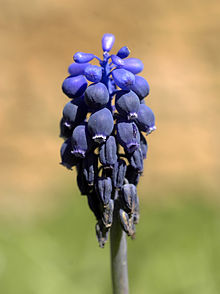|
Muscari neglectum
Muscari neglectum is a perennial bulbous flowering plant in the asparagus family Asparagaceae. Members of this genus are commonly known as grape hyacinths, and M. neglectum is known as common grape hyacinth[1] or starch grape hyacinth.[2] Muscari are perennial bulbous plants native to Eurasia. They produce spikes of dense, commonly blue, urn-shaped flowers. It is sometimes grown as an ornamental plant, for example, in temperate climates as a spring bulb. DescriptionMuscari neglectum is a herbaceous plant growing from a bulb. The flower stems are 5–20 cm tall. The flowers are arranged in a spike or raceme and are dark blue with white lobes at their tips (teeth); there may be a cluster of paler sterile flowers at the top of the spike.[3] The raceme is 2–6 cm long. The fruit is a 3-celled capsule with two ovules in each cell.[4] It is a very well known species in cultivation (being described as the "common" grape hyacinth by Brian Mathew);[3] it increases rapidly and can become invasive. TaxonomyThe name was attributed to Giovanni Gussone by Michele Tenore in a list of plants of the Neapolitan area published in 1842. The species has a confused nomenclatural history; no fewer than 46 full species names are listed as synonyms in the Kew World Checklist of Selected Plant Families.[5] The name M. racemosum is commonly found as a synonym for M. neglectum in the horticultural literature,[6] although the true M. racemosum Mill. is a different species.[7] References
External linksWikimedia Commons has media related to Muscari neglectum. |
||||||||||||||||||||||||||||||||
